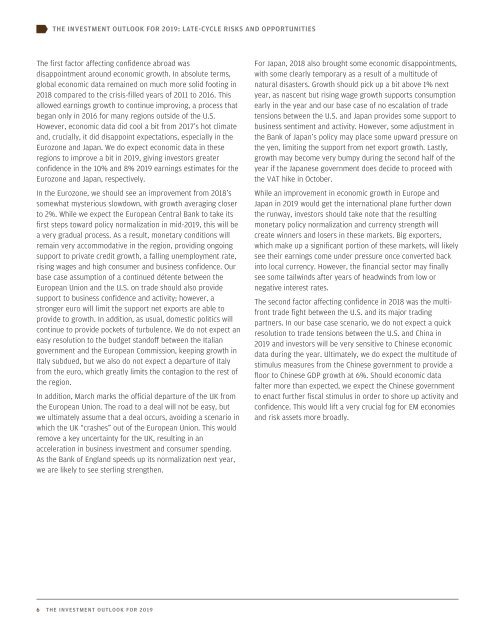Create successful ePaper yourself
Turn your PDF publications into a flip-book with our unique Google optimized e-Paper software.
THE INVESTMENT OUTLOOK FOR 2019: LATE-CYCLE RISKS AND OPPORTUNITIES<br />
The first factor affecting confidence abroad was<br />
disappointment around economic growth. In absolute terms,<br />
global economic data remained on much more solid footing in<br />
2018 compared to the crisis-filled years of 2011 to 2016. This<br />
allowed earnings growth to continue improving, a process that<br />
began only in 2016 for many regions outside of the U.S.<br />
However, economic data did cool a bit from 2017’s hot climate<br />
and, crucially, it did disappoint expectations, especially in the<br />
Eurozone and Japan. We do expect economic data in these<br />
regions to improve a bit in 2019, giving investors greater<br />
confidence in the 10% and 8% 2019 earnings estimates for the<br />
Eurozone and Japan, respectively.<br />
In the Eurozone, we should see an improvement from 2018’s<br />
somewhat mysterious slowdown, with growth averaging closer<br />
to 2%. While we expect the European Central Bank to take its<br />
first steps toward policy normalization in mid-2019, this will be<br />
a very gradual process. As a result, monetary conditions will<br />
remain very accommodative in the region, providing ongoing<br />
support to private credit growth, a falling unemployment rate,<br />
rising wages and high consumer and business confidence. Our<br />
base case assumption of a continued détente between the<br />
European Union and the U.S. on trade should also provide<br />
support to business confidence and activity; however, a<br />
stronger euro will limit the support net exports are able to<br />
provide to growth. In addition, as usual, domestic politics will<br />
continue to provide pockets of turbulence. We do not expect an<br />
easy resolution to the budget standoff between the Italian<br />
government and the European Commission, keeping growth in<br />
Italy subdued, but we also do not expect a departure of Italy<br />
from the euro, which greatly limits the contagion to the rest of<br />
the region.<br />
In addition, March marks the official departure of the UK from<br />
the European Union. The road to a deal will not be easy, but<br />
we ultimately assume that a deal occurs, avoiding a scenario in<br />
which the UK “crashes” out of the European Union. This would<br />
remove a key uncertainty for the UK, resulting in an<br />
acceleration in business investment and consumer spending.<br />
As the Bank of England speeds up its normalization next year,<br />
we are likely to see sterling strengthen.<br />
For Japan, 2018 also brought some economic disappointments,<br />
with some clearly temporary as a result of a multitude of<br />
natural disasters. Growth should pick up a bit above 1% next<br />
year, as nascent but rising wage growth supports consumption<br />
early in the year and our base case of no escalation of trade<br />
tensions between the U.S. and Japan provides some support to<br />
business sentiment and activity. However, some adjustment in<br />
the Bank of Japan’s policy may place some upward pressure on<br />
the yen, limiting the support from net export growth. Lastly,<br />
growth may become very bumpy during the second half of the<br />
year if the Japanese government does decide to proceed with<br />
the VAT hike in October.<br />
While an improvement in economic growth in Europe and<br />
Japan in 2019 would get the international plane further down<br />
the runway, investors should take note that the resulting<br />
monetary policy normalization and currency strength will<br />
create winners and losers in these markets. Big exporters,<br />
which make up a significant portion of these markets, will likely<br />
see their earnings come under pressure once converted back<br />
into local currency. However, the financial sector may finally<br />
see some tailwinds after years of headwinds from low or<br />
negative interest rates.<br />
The second factor affecting confidence in 2018 was the multifront<br />
trade fight between the U.S. and its major trading<br />
partners. In our base case scenario, we do not expect a quick<br />
resolution to trade tensions between the U.S. and China in<br />
2019 and investors will be very sensitive to Chinese economic<br />
data during the year. Ultimately, we do expect the multitude of<br />
stimulus measures from the Chinese government to provide a<br />
floor to Chinese GDP growth at 6%. Should economic data<br />
falter more than expected, we expect the Chinese government<br />
to enact further fiscal stimulus in order to shore up activity and<br />
confidence. This would lift a very crucial fog for EM economies<br />
and risk assets more broadly.<br />
6 THE INVESTMENT OUTLOOK FOR 2019
















